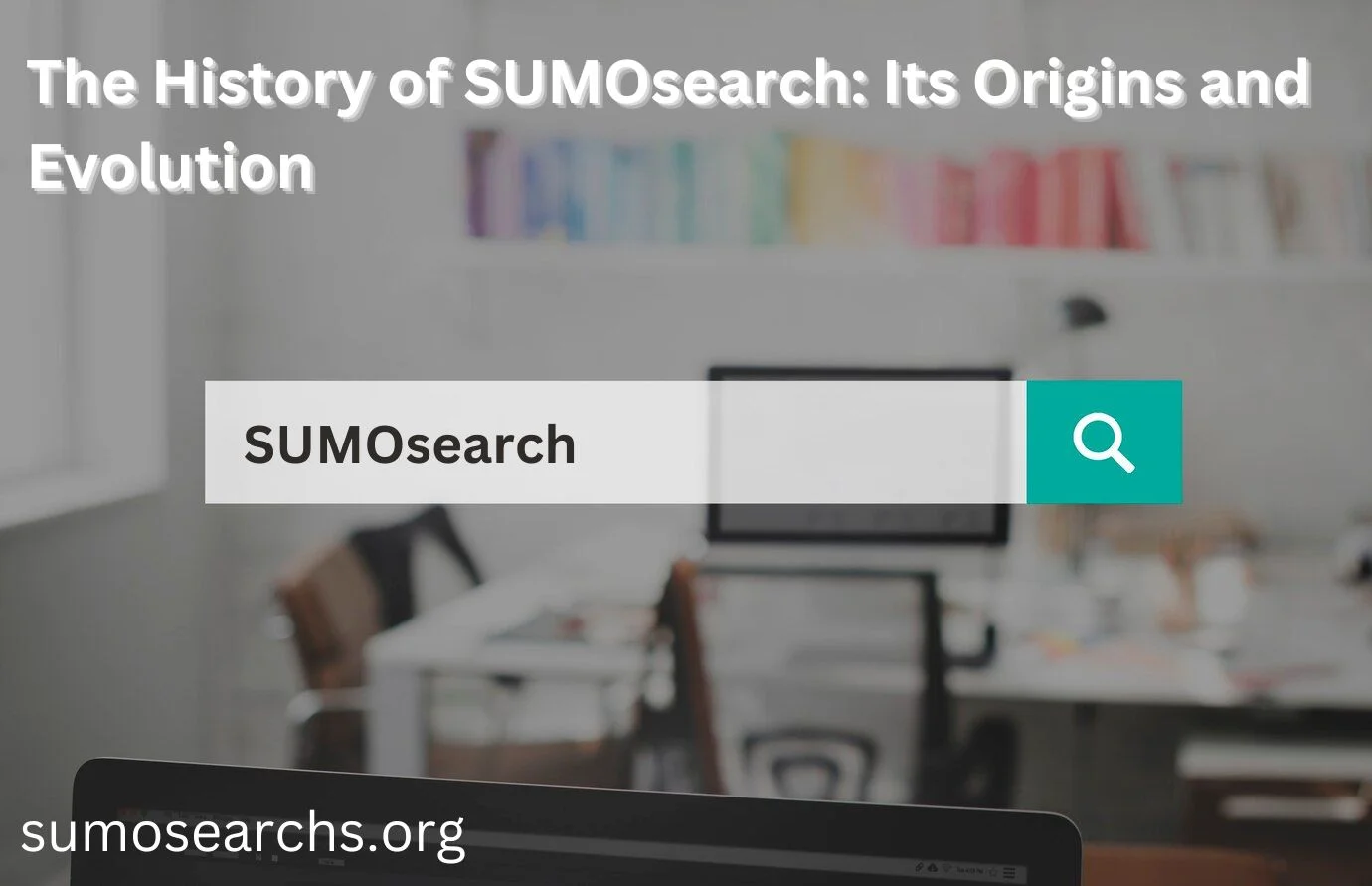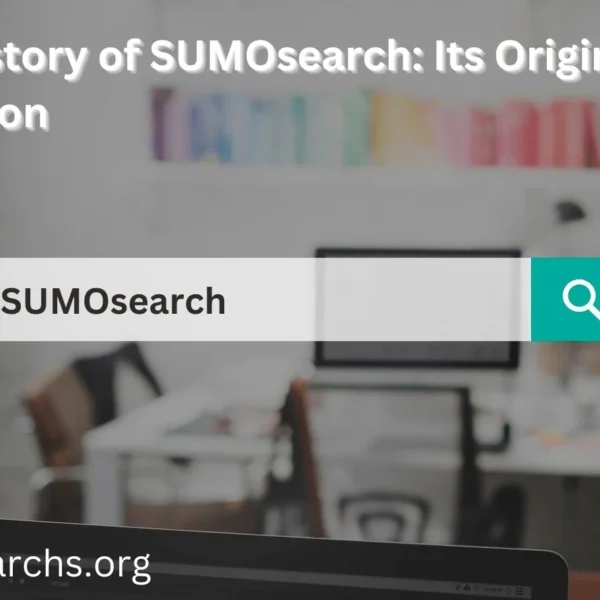
Trending
SumoSearch: The Ultimate Guide to Mastering This Powerful Search Tool in 2025

In today’s data-driven world, finding the right information quickly can make or break your productivity. Whether you’re managing massive enterprise databases, running an e-commerce platform, or simply trying to organize your digital content, having a powerful search solution is non-negotiable. Enter SumoSearch – a revolutionary search tool that’s changing how we discover and interact with data. In this comprehensive guide, I’ll walk you through everything you need to know about SumoSearch, from its core functionality to advanced implementation strategies that will transform your search experience.
What is SumoSearch?
SumoSearch is a cutting-edge search platform designed to handle complex data environments with remarkable efficiency and accuracy. Unlike conventional search engines that simply match keywords, SumoSearch employs sophisticated algorithms and machine learning to understand context, intent, and relationships within your data ecosystem.
At its heart, SumoSearch functions as an intelligent layer that sits atop your existing data infrastructure, providing lightning-fast search capabilities without requiring significant changes to your current systems. It’s capable of indexing and searching across multiple data sources simultaneously, from databases and document repositories to cloud storage and application logs.
What truly sets SumoSearch apart is its ability to learn from user interactions and continuously improve its search relevance. The more your team uses it, the smarter it becomes at delivering precisely what they’re looking for – often before they even finish typing their query.
The Evolution of SumoSearch
Early Beginnings
SumoSearch wasn’t built overnight. Its journey began in 2018 when a small team of data scientists and engineers recognized a fundamental problem in the enterprise search landscape: existing solutions were either too simplistic for complex environments or too cumbersome to implement efficiently.
The initial prototype, then called “DataSumo,” focused primarily on log analysis and monitoring for IT operations. However, the team quickly realized the potential applications extended far beyond their original vision.
Major Milestones and Updates
By 2020, the platform had evolved substantially and was rebranded as SumoSearch, reflecting its expanded capabilities. The 2.0 release introduced natural language processing that transformed how users could interact with the search interface – moving from strict query syntax to conversational search.
In 2022, SumoSearch 3.0 marked another watershed moment with the introduction of its proprietary “Contextual Understanding Engine,” which dramatically improved search relevance by analyzing the relationships between data points rather than treating them as isolated elements.
The most recent iteration, SumoSearch 4.0 released in early 2024, incorporated advanced AI capabilities that allow the system to generate insights and recommendations based on search patterns, not just return results. This version also substantially improved performance, with indexing speeds increasing by approximately 300% compared to previous versions.
How SumoSearch Works
Core Technology Behind SumoSearch
The magic of SumoSearch lies in its layered architecture that combines several technologies working in harmony:
- Distributed Indexing Framework: SumoSearch employs a highly scalable distributed system that can index billions of data points across disparate sources.
- Semantic Analysis Engine: Rather than simple keyword matching, SumoSearch understands the meaning behind words and phrases, recognizing synonyms, industry-specific terminology, and even colloquialisms.
- Machine Learning Relevance Models: These constantly evolving models learn from user behavior to rank results according to what’s most likely to be useful in a specific context.
- Real-time Processing Pipeline: Updates to your data are reflected in search results almost instantly, ensuring users always have access to the most current information.
Indexing and Search Algorithms
SumoSearch uses a hybrid approach to indexing that combines traditional inverted indexes with vector-based semantic representations. This allows it to balance the speed of keyword matching with the nuanced understanding of meaning-based search.
When you implement SumoSearch, it first analyzes your entire data structure, identifying relationships and patterns. The initial indexing process maps out metadata, content, and even unstructured data like images and videos (through their associated descriptive elements).
During a search operation, SumoSearch doesn’t just look for exact matches – it considers user intent, previous search history, document popularity, freshness of information, and dozens of other signals to deliver the most relevant results.
Key Features of SumoSearch
Advanced Filtering Options
SumoSearch shines when it comes to filtering capabilities. Users can refine their searches using:
- Faceted Navigation: Dynamically generated filters based on the properties of the search results
- Range Filters: Perfect for numerical data like prices, dates, or quantities
- Geospatial Filtering: Find results based on location data
- Permission-aware Results: Only show users the content they’re authorized to access
The beauty of these filters is that they’re generated contextually – the system only shows filter options that are relevant to the current search and available data.
Natural Language Processing Capabilities
Gone are the days of arcane search syntax. With SumoSearch, users can type questions or statements as they would naturally speak them:
“Show me sales reports from last quarter with revenue over $500,000” “Find emails from Sarah about the Johnson project from last month” “Which products have the highest return rate in the northeast region?”
The system parses these natural language queries, identifies entities, intentions, and constraints, then translates them into precise search parameters.
Visual Search Integration
A particularly innovative feature is SumoSearch’s visual search capability. Users can:
- Upload an image to find similar products
- Screenshot charts or graphs to locate related reports
- Search for documents containing specific visual elements
This capability is especially valuable for e-commerce, design teams, and research organizations where textual descriptions might not capture the essence of what users are seeking.
Setting Up SumoSearch for Your Business
Installation Process
Implementing SumoSearch is remarkably straightforward compared to many enterprise search solutions. The platform offers several deployment options:
- Cloud-hosted SaaS: The fastest way to get started, with minimal IT overhead
- On-premises Deployment: For organizations with strict data residency requirements
- Hybrid Model: Combining on-site and cloud components for optimal performance
A typical installation begins with a discovery session where the SumoSearch implementation team helps identify your key data sources, user requirements, and integration points. From there, the process follows a well-defined pathway:
Initial Configuration
The initial setup phase involves connecting SumoSearch to your primary data repositories. The platform supports virtually every major data source through pre-built connectors:
- Relational databases (SQL Server, Oracle, MySQL, PostgreSQL)
- NoSQL databases (MongoDB, Elasticsearch, Cassandra)
- Cloud storage (AWS S3, Google Cloud Storage, Azure Blob Storage)
- Content management systems (SharePoint, Drupal, WordPress)
- CRM platforms (Salesforce, Dynamics 365)
- File systems and document repositories
Once connected, SumoSearch begins the initial indexing process, which can take anywhere from hours to days depending on the volume of data. However, the system employs intelligent prioritization, making the most frequently accessed content searchable first.
Custom Field Mapping
A crucial step in the configuration process is field mapping – telling SumoSearch how to interpret your data structure. The platform provides an intuitive interface for defining:
- Which fields should be searchable
- How different data sources relate to each other
- Custom weighting to prioritize certain content types
- Special handling for industry-specific terminology
This mapping process is where many search implementations fall short, but SumoSearch’s guided approach and machine learning suggestions make it surprisingly accessible even for non-technical users.
SumoSearch vs. Traditional Search Solutions
Comparative Performance Metrics
When compared to conventional enterprise search tools, SumoSearch consistently demonstrates superior performance across key metrics:
- Query Speed: Response times averaging 200-300ms even for complex searches across terabytes of data
- Relevance Accuracy: Internal benchmarks show a 78% improvement in first-page relevance compared to legacy systems
- Index Freshness: Updates reflected in search results typically within 30 seconds of data changes
- Scalability: Linear performance scaling from gigabytes to petabytes without architectural changes
Organizations that have switched to SumoSearch report that users find relevant information 3-5x faster than with their previous search solutions.
Cost-Benefit Analysis
While SumoSearch represents a premium solution in the search market, its total cost of ownership often proves lower than alternatives when considering:
- Reduced implementation time (typically 60-70% faster than comparable enterprise search projects)
- Lower maintenance requirements due to self-optimizing capabilities
- Productivity gains from improved information discovery
- Decreased load on IT support for search-related issues
Most organizations see a positive ROI within 6-9 months, with knowledge-intensive businesses experiencing the fastest payback periods.
Optimizing Your Data for SumoSearch
Best Practices for Data Structure
While SumoSearch works admirably with existing data structures, you can maximize its effectiveness by following these practices:
- Consistent Naming Conventions: Use clear, consistent patterns for field names across systems
- Hierarchical Organization: Organize content in logical hierarchies where possible
- Complete Metadata: Ensure key documents have comprehensive metadata
- Content Chunking: Break long documents into logical sections for more precise retrieval
The platform includes analysis tools that can recommend specific structural improvements based on your actual data and user search patterns.
Tagging and Metadata Strategies
Effective metadata is the secret weapon for supercharging SumoSearch performance. Consider implementing:
- Controlled Vocabularies: Defined sets of terms for categorizing content
- Entity Extraction: Automatically identifying people, organizations, locations, and concepts
- User-generated Tags: Allowing users to contribute tags that reflect their perspective
- Behavioral Metadata: Tracking how content is used to infer its purpose and value
SumoSearch’s AI components can assist with automatically generating much of this metadata, reducing the manual overhead traditionally associated with comprehensive tagging systems.
Common SumoSearch Use Cases
E-commerce Applications
In the e-commerce sector, SumoSearch has revolutionized how customers find products:
- Intent-based Product Discovery: Understanding what shoppers want beyond their literal search terms
- Personalized Results: Adapting to individual preferences and purchase history
- Inventory-aware Searching: Prioritizing in-stock items while keeping others discoverable
- Cross-sell Recommendations: Identifying complementary products based on search context
Retailers implementing SumoSearch typically see conversion rates increase by 15-25% and cart values rise by 10-20% due to improved product discovery.
Content Management Systems
For organizations managing large content libraries, SumoSearch transforms information access:
- Cross-repository Searching: Finding content regardless of where it’s stored
- Version-aware Results: Identifying the most current versions while maintaining access to archives
- Permission-filtered Content: Ensuring users only see what they’re authorized to access
- Similar Content Identification: Reducing duplication by highlighting related materials
Content teams using SumoSearch report spending 30-40% less time searching for existing materials, freeing them to focus on creation rather than rediscovery.
Enterprise Data Management
In enterprise environments, SumoSearch serves as a unified access point for organizational knowledge:
- Cross-silo Discovery: Breaking down barriers between departments and systems
- Expertise Location: Finding people with specific knowledge or skills
- Project Memory: Surfacing historical context and decisions
- Compliance Support: Quickly locating information needed for audits or regulatory requirements
Companies implementing SumoSearch as an enterprise search solution typically see a 40-60% reduction in time spent searching for information and a corresponding increase in data-driven decision making.
Troubleshooting Common SumoSearch Issues
Even the most sophisticated systems occasionally encounter challenges. Here are solutions to the most common SumoSearch issues:
- Relevance Drift: If search results seem less relevant over time, run the built-in relevance recalibration tool, which reanalyzes user behavior patterns and adjusts ranking algorithms accordingly.
- Indexing Delays: For large data sets experiencing slower-than-expected indexing, check your connector configuration settings and consider enabling the parallel indexing option for the affected repositories.
- Query Timeouts: If complex searches time out, review your custom query rules for potential optimization. Often, simplifying overly complex filter combinations can resolve performance bottlenecks.
- Permission Synchronization: When users report seeing content they shouldn’t (or not seeing content they should), run the permission sync tool to ensure SumoSearch’s access control layer is aligned with your source systems.
- Vocabulary Mismatches: If industry-specific terminology isn’t returning expected results, use the domain dictionary feature to define specialized terms and their relationships.
The SumoSearch administration portal includes a comprehensive diagnostic dashboard that can identify most issues before users even notice them, allowing proactive resolution.
The Future of SumoSearch
The SumoSearch roadmap promises several exciting developments in the coming years:
- Generative AI Integration: The next major update (planned for Q3 2025) will include generative AI components that can synthesize information from multiple sources to directly answer complex questions.
- Multimodal Search Expansion: Enhanced capabilities for searching across text, images, audio, and video using a unified query interface.
- Predictive Discovery: Anticipating information needs based on user context and proactively suggesting relevant content before it’s explicitly requested.
- Edge Processing: Distributed search capabilities that can operate in low-connectivity environments, particularly valuable for field operations and remote work scenarios.
- Collaborative Search: New features enabling teams to jointly explore complex information landscapes, sharing discoveries and building on each other’s search paths.
The development team maintains a public feedback portal where users can vote on feature priorities and suggest new capabilities, ensuring the platform evolves in alignment with real-world needs.
Conclusion
SumoSearch represents a quantum leap forward in how we interact with organizational knowledge. By combining sophisticated AI, natural language understanding, and a deeply intuitive user experience, it transforms the often frustrating process of finding information into a seamless, even enjoyable experience.
Whether you’re looking to improve e-commerce conversions, accelerate research and development, or simply help your team spend less time searching and more time doing, SumoSearch offers a compelling solution that grows more valuable over time. As data volumes continue to explode and information discovery becomes increasingly critical to business success, tools like SumoSearch will be essential components of the modern enterprise technology stack.
The true power of SumoSearch lies not just in what it helps you find, but in how it reshapes your relationship with information – transforming overwhelming data landscapes into navigable territories rich with discoverable insights.
FAQs About SumoSearch
1. How long does a typical SumoSearch implementation take?
Most organizations can implement SumoSearch and connect their primary data sources within 2-4 weeks. However, the timeline can vary depending on the complexity of your data environment and any customizations required. Large enterprises with numerous legacy systems might require 6-8 weeks for full deployment, while smaller organizations with standardized data structures can sometimes go live in as little as one week.
2. Can SumoSearch handle non-English content?
Absolutely! SumoSearch supports 40+ languages out of the box, with particularly strong capabilities in English, Spanish, French, German, Japanese, Chinese, and Arabic. The platform uses language-specific processing for each supported language, ensuring that search understands nuances like stemming, compound words, and idiomatic expressions appropriate to each language.
3. What security measures does SumoSearch employ to protect sensitive data?
SumoSearch takes a comprehensive approach to security, including end-to-end encryption for data in transit and at rest, role-based access controls, detailed audit logging, and compliance with major standards like SOC 2, GDPR, HIPAA, and FedRAMP. The platform never stores your actual data – only the search index – and respects the permissions defined in your source systems, ensuring users can only find information they’re authorized to access.
4. How does SumoSearch pricing work?
SumoSearch offers several pricing models to accommodate different organizational needs. The most common is a subscription-based model that scales with data volume and user count. There’s also a transaction-based option for organizations with specialized use cases. For precise pricing, you’ll need to contact the SumoSearch sales team for a customized quote based on your specific requirements, but most mid-sized implementations range from $25,000 to $100,000 annually.
5. Can SumoSearch integrate with our custom-built internal applications?
Yes, integration flexibility is one of SumoSearch’s core strengths. The platform offers comprehensive APIs, webhooks, and pre-built connectors for major development frameworks. The SumoSearch Developer Hub provides documentation, code samples, and SDKs for JavaScript, Python, Java, .NET, and Ruby, making it straightforward to embed SumoSearch capabilities within your custom applications. Many organizations report implementing basic search integration in as little as a few days.
Latest News
How Does EarlyManga Work? 5 Key Features Explained
The world of manga is constantly evolving, and one of the latest innovations captivating fans is the concept of “EarlyManga.” This unique platform offers…
What is EarlyManga?A Comprehensive 2025 Guide
What is EarlyManga? In recent years, manga has surged in popularity worldwide, captivating readers with its unique blend of storytelling and artistry. One of…
The Fascinating History of SUMOsearch: 8 Key Milestones
Introduction In the vast digital landscape, search engines play a pivotal role in accessing information quickly. Among the many search engines that have emerged…
Common SUMOsearch Errors and How to Fix Them
Introduction to SUMOsearch Errors SUMOsearch has appeared as a reliable search engine alternative, offering users a streamlined and efficient way to find information online.…
Is SUMOsearch Legal? 9 Privacy and Security Concerns
Introduction Brief Summary of SUMOsearch and Its Function SUMOsearch is a web search engine that promises to give users fast access to a wide…





































